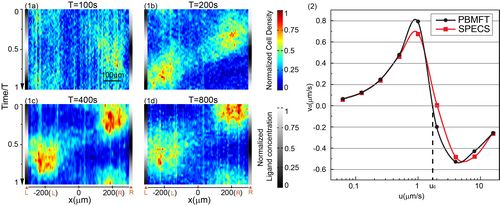The team of Professor Ouyang Qi of the School of Physics of Peking University cooperated with Professor Tu Yuhai of the IBM TJ Watson Institute in the United States. In a recent study, he discovered a new phenomenon of bacterial chemotaxis behavior under the environment of time and space changes, and proposed a description based on individual molecular mechanisms The average field model of group behavior. The research results have been published in the last two issues of "Physical Review Letters" (Frequency-Dependent Escherichia coli Chemotaxis Behavior. Xuejun Zhu, Guangwei Si, Nianpei Deng, Qi Ouyang, Tailin Wu, Zhuoran He, Lili Jiang, Chunxiong Luo and Yuhai Tu , Phys. Rev. Lett. 108, 128101 (2012). And Pathway-based mean-field model for Escherichia coli chemotaxis. Guangwei Si, Tailin Wu, Qi Ouyang and Yuhai Tu. Phys. Rev. Lett. 109, 048101 (2012 )).
Sensing changes in the external environment and reacting to them, seeking benefits and avoiding harm are the basic skills of life survival. The chemotactic behavior of E. coli is the simplest and most basic material for studying this universal survival strategy. Bacteria can sense changes in the concentration of surrounding chemicals and adjust their movements to find food or escape from harsh environments. Traditional research is generally conducted under quasi-static concentration gradients, and the living environment of bacteria is constantly changing. The response behavior of the chemotactic mechanism evolved in such a complex environment in the face of spatiotemporal changes in concentration gradient There is no in-depth understanding. In the work "Frequency-Dependent Escherichia coli Chemotaxis Behavior", the team used microfluidic technology to achieve a time change from tens of seconds to tens of seconds on the spatial scale of 100 microns. Accurate control of the concentration gradient of the spatio-temporal changes in minutes and quantitatively observed the response behavior of E. coli to the concentration environment of the standing wave change of aspartic acid. It was found that the pattern of bacterial group behavior depends on the change frequency of the concentration field: at low frequencies, the movement of the bacteria group is synchronized with the change of the concentration field; while at high frequencies, the response of the bacteria group becomes weak and lags behind the change of the concentration signal, even Will choose to gather in low concentration areas (as shown in Figure 1a-1d). This phenomenon is contrary to the classical bacterial population chemotaxis model. After considering the molecular mechanism of chemotaxis, the revised model can make a quantitative explanation of the experimental phenomenon. The limited adaptation rate of bacteria leads to the abnormal behavior of the flora at high frequencies, and the classical phenomenological model is an approximation when the adaptation rate takes the limit.
Current biological research has yielded fruitful results at all scales, from single molecules to regulatory pathways, from individuals to groups; however, there are relatively few studies from a systemic perspective to link different scales. At the same time, connecting multiple levels of time and space from the molecular level to the group level is a big challenge in itself. The research results of E. coli in the field of chemotaxis for many years have provided the basis for systematic modeling; the discovery of abnormal behavior in the above microfluidic experiments also provides an opportunity for reexamination of the classic model. In the work "Pathway-based mean-field model for Escherichia coli chemotaxis.", The team set up from the signal transduction pathway of E. coli chemotaxis and established The average field model that describes the behavior of the bacterial population builds a bridge between the population level and the molecular level. The group motion parameters obtained by the model can be linked to the biochemical reaction process at the molecular level, for example, the chemotaxis speed is proportional to the size of the co-sensing receptor cluster and the Hill coefficient of the motor's super-sensitive response curve. The model successfully explained the relationship between the scaling rate of the maximum group chemotaxis and individual adaptation rate. The new model also predicts that the classic model cannot explain the new phenomenon: the direction of the chemotaxis speed will reverse in the traveling wave environment (see Figure 2). This multi-scale modeling method can be used in the study of other biological systems, such as population response and biofilm formation.
The first authors of the two papers, Zhu Xuejun and Si Guangwei, are 08-level interdisciplinary doctoral students recruited by the Center for Quantitative Biology of Peking University. Their backgrounds are biology and physics. Associate Professor Luo Chunxiong of the School of Physics of Peking University is the main designer of the microfluidic device in the experiment, and he co-directed the experimental work of graduate students.

Figure 1a-b: Spatiotemporal distribution of bacterial density at different cycles in an oscillating concentration environment. Bacterial behavior depends on the frequency of the signal (Source: Phys. Rev. Lett. 108, 128101 (2012)). Figure 2: A new model based on molecular mechanism predicts that in the traveling wave concentration environment, the bacterial group velocity will change with the change of wave velocity: when the wave velocity is greater than uc, the chemotaxis velocity will be reversed (Source Phys. Rev. Lett. 109, 048101 (2012)).
Face Makeup,Makeup Eyeshadow,Concealer High Coverage,Liquid Foundation
Suzhou Yimeijia368 Biological Technology Co.,Ltd. , https://www.yimeijiabeauty.com